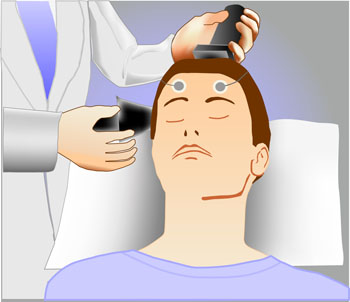ECT Update: Some good news and some not-so-good news
 A 2013 study by Prudic et al. in the Journal of Electro-convulsive Therapy reveals some good and some not-so-good news about ECT. The good news about ECT is that it produced moderate acute remission rates. In this randomized study of ECT treatment, improvement rates were better when patients received right unilateral (RUL) ultra-brief pulse at high doses (6 times a patient’s seizure threshold) than with bilateral (BL) pulse at low doses (1.5 times the patient’s seizure threshold). RUL also has fewer cognitive side effects than BL.
A 2013 study by Prudic et al. in the Journal of Electro-convulsive Therapy reveals some good and some not-so-good news about ECT. The good news about ECT is that it produced moderate acute remission rates. In this randomized study of ECT treatment, improvement rates were better when patients received right unilateral (RUL) ultra-brief pulse at high doses (6 times a patient’s seizure threshold) than with bilateral (BL) pulse at low doses (1.5 times the patient’s seizure threshold). RUL also has fewer cognitive side effects than BL.
Prudic also found that these acute remission rates were best when antidepressant treatment was begun at the same time as ECT rather than after the end of ECT treatment.
Unfortunately, a previous study by Prudic et al. showed that relapse rates after ECT remain high. Two-thirds of patients relapse in the first six months after ECT. Half of patients who receive antidepressant treatment following ECT relapse within the first six months after their last ECT treatment. Twenty to forty percent relapse in the first month after their last ECT treatment.
In the current study, timing and likelihood of relapse was independent of whether antidepressant treatment was started at the outset of ECT or after the end of ECT. Relapse also did not depend on which pharmacological treatments are used (nortriptyine plus lithium versus venlafaxine plus lithium).
Older patients (average age 55) did better—they relapsed less often than patients with an average age of 45. Patients with unipolar and bipolar depression did not differ in relapse rates.
Previous history of illness did affect relapse. The number of prior antidepressant trials a patient had tried for a current depressive episode (a measure of treatment resistance) was related to how fast they relapsed on follow-up pharmacotherapy after receiving ECT (more antidepressant trials was associated with faster relapse).
Other studies have shown that continuation of ECT treatment is not superior to continued treatment with drugs following ECT treatment.
Editor’s Note: ECT works acutely, but too often its effects do not last long, even with intensive continuation treatment with an antidepressant and lithium. Therefore for patients with highly recurrent illness, its usefulness is largely limited to acute emergencies, such as high risk of suicide or medical deterioration.
There are currently no good controlled studies showing how to prevent depressive relapse after remission with ECT using either drug continuation therapy or maintenance ECT. Greater degrees of treatment resistance are associated with lower rates of both acute remission and faster relapse during follow-up pharmacotherapy.
If a patient is going to have ECT, RUL would be recommended over bilateral, because bilateral ECT is associated with decreases in autobiographical memory even after six months, and these deficits are in proportion to the number of bilateral ECT treatments received.
Alternatives to ECT
Other types of brain stimulation treatments could potentially serve as alternatives to ECT.
Unlike ECT, whose effects rapidly wane, the therapeutic effects of vagal nerve stimulation (VNS) are unique in that they appear to increase over time, while side effects (such as hoarseness) decrease.
Repeated transcranial magnetic stimulation (rTMS) has fewer side effects (especially cognitive ones) than ECT, but like ECT there are no definitive procedures for dealing with maintaining its effectiveness for the long term.
Given the large number of potential pharmacoprophylactic approaches for recurrent unipolar and bipolar disorders, in non-emergency situations this editor prefers to explore drug options in depth in the hopes of both achieving remission and maintaining it with continuation of that same regimen.
The number of prior depressions a patient has had is a risk factor not only for treatment resistance, but also for cognitive dysfunction. Therefore it appears prudent to institute long-term preventative treatment with antidepressants after a second or third unipolar depressive episode (as recommended in most treatment guidelines) or with lithium, mood stabilizers, or atypical antipsychotics after a first or second manic episode in bipolar disorder in order to prevent the accumulation of mood episodes, which have deleterious effects on a patient’s medical and psychiatric health, cognitive function, and longevity. It has not yet been definitively proven, but there is much to suggest the wisdom of the mantra: “Prevent Episodes, Protect The Brain.”
Instituting and maintaining early and long-term prophylaxis will likely require patients to take an active role in ensuring that episodes are treated to remission and in maintaining this remission with careful long-term preventive treatment and monitoring.
The duration of time well on preventive treatment is not a good predictor of likely continued wellness if effective drug treatment is discontinued. So until there are data to the contrary, the safest approach is long-term continuation of what is working well.

